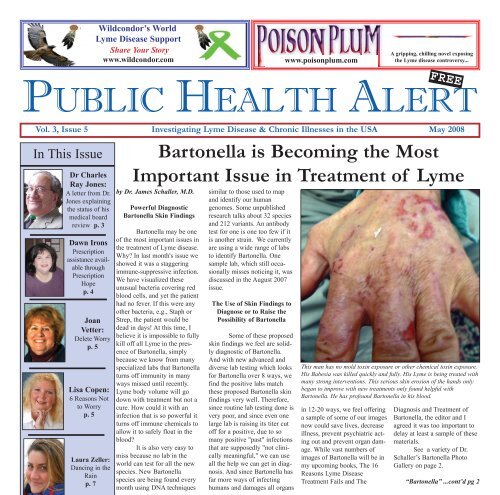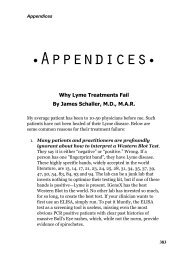Bartonella is Becoming the Most Important Issue in Treatment of Lyme
Bartonella is Becoming the Most Important Issue in Treatment of Lyme
Bartonella is Becoming the Most Important Issue in Treatment of Lyme
You also want an ePaper? Increase the reach of your titles
YUMPU automatically turns print PDFs into web optimized ePapers that Google loves.
Wildcondor’s World<br />
<strong>Lyme</strong> D<strong>is</strong>ease Support<br />
Share Your Story<br />
www.wildcondor.com<br />
www.po<strong>is</strong>onplum.com<br />
A gripp<strong>in</strong>g, chill<strong>in</strong>g novel expos<strong>in</strong>g<br />
<strong>the</strong> <strong>Lyme</strong> d<strong>is</strong>ease controversy...<br />
FREE<br />
PUBLIC HEALTH ALERT<br />
Vol. 3, <strong>Issue</strong> 5 Investigat<strong>in</strong>g <strong>Lyme</strong> D<strong>is</strong>ease & Chronic Illnesses <strong>in</strong> <strong>the</strong> USA May 2008<br />
In Th<strong>is</strong> <strong>Issue</strong><br />
Dr Charles<br />
Ray Jones:<br />
A letter from Dr.<br />
Jones expla<strong>in</strong><strong>in</strong>g<br />
<strong>the</strong> status <strong>of</strong> h<strong>is</strong><br />
medical board<br />
review p. 3<br />
Dawn Irons<br />
Prescription<br />
ass<strong>is</strong>tance available<br />
through<br />
Prescription<br />
Hope<br />
p. 4<br />
Joan<br />
Vetter:<br />
Delete Worry<br />
p. 5<br />
L<strong>is</strong>a Copen:<br />
6 Reasons Not<br />
to Worry<br />
p. 5<br />
Laura Zeller:<br />
Danc<strong>in</strong>g <strong>in</strong> <strong>the</strong><br />
Ra<strong>in</strong><br />
p. 7<br />
<strong>Bartonella</strong> <strong>is</strong> <strong>Becom<strong>in</strong>g</strong> <strong>the</strong> <strong>Most</strong><br />
<strong>Important</strong> <strong>Issue</strong> <strong>in</strong> <strong>Treatment</strong> <strong>of</strong> <strong>Lyme</strong><br />
by Dr. James Schaller, M.D.<br />
Powerful Diagnostic<br />
<strong>Bartonella</strong> Sk<strong>in</strong> F<strong>in</strong>d<strong>in</strong>gs<br />
<strong>Bartonella</strong> may be one<br />
<strong>of</strong> <strong>the</strong> most important <strong>is</strong>sues <strong>in</strong><br />
<strong>the</strong> treatment <strong>of</strong> <strong>Lyme</strong> d<strong>is</strong>ease.<br />
Why In last month's <strong>is</strong>sue we<br />
showed it was a stagger<strong>in</strong>g<br />
immune-suppressive <strong>in</strong>fection.<br />
We have v<strong>is</strong>ualized <strong>the</strong>se<br />
unusual bacteria cover<strong>in</strong>g red<br />
blood cells, and yet <strong>the</strong> patient<br />
had no fever. If th<strong>is</strong> were any<br />
o<strong>the</strong>r bacteria, e.g., Staph or<br />
Strep, <strong>the</strong> patient would be<br />
dead <strong>in</strong> days! At th<strong>is</strong> time, I<br />
believe it <strong>is</strong> impossible to fully<br />
kill <strong>of</strong>f all <strong>Lyme</strong> <strong>in</strong> <strong>the</strong> presence<br />
<strong>of</strong> <strong>Bartonella</strong>, simply<br />
because we know from many<br />
specialized labs that <strong>Bartonella</strong><br />
turns <strong>of</strong>f immunity <strong>in</strong> many<br />
ways m<strong>is</strong>sed until recently.<br />
<strong>Lyme</strong> body volume will go<br />
down with treatment but not a<br />
cure. How could it with an<br />
<strong>in</strong>fection that <strong>is</strong> so powerful it<br />
turns <strong>of</strong>f immune chemicals to<br />
allow it to safely float <strong>in</strong> <strong>the</strong><br />
blood<br />
It <strong>is</strong> also very easy to<br />
m<strong>is</strong>s because no lab <strong>in</strong> <strong>the</strong><br />
world can test for all <strong>the</strong> new<br />
species. New <strong>Bartonella</strong><br />
species are be<strong>in</strong>g found every<br />
month us<strong>in</strong>g DNA techniques<br />
similar to those used to map<br />
and identify our human<br />
genomes. Some unpubl<strong>is</strong>hed<br />
research talks about 32 species<br />
and 212 variants. An antibody<br />
test for one <strong>is</strong> one too few if it<br />
<strong>is</strong> ano<strong>the</strong>r stra<strong>in</strong>. We currently<br />
are us<strong>in</strong>g a wide range <strong>of</strong> labs<br />
to identify <strong>Bartonella</strong>. One<br />
sample lab, which still occasionally<br />
m<strong>is</strong>ses notic<strong>in</strong>g it, was<br />
d<strong>is</strong>cussed <strong>in</strong> <strong>the</strong> August 2007<br />
<strong>is</strong>sue.<br />
The Use <strong>of</strong> Sk<strong>in</strong> F<strong>in</strong>d<strong>in</strong>gs to<br />
Diagnose or to Ra<strong>is</strong>e <strong>the</strong><br />
Possibility <strong>of</strong> <strong>Bartonella</strong><br />
Some <strong>of</strong> <strong>the</strong>se proposed<br />
sk<strong>in</strong> f<strong>in</strong>d<strong>in</strong>gs we feel are solidly<br />
diagnostic <strong>of</strong> <strong>Bartonella</strong>.<br />
And with new advanced and<br />
diverse lab test<strong>in</strong>g which looks<br />
for <strong>Bartonella</strong> over 8 ways, we<br />
f<strong>in</strong>d <strong>the</strong> positive labs match<br />
<strong>the</strong>se proposed <strong>Bartonella</strong> sk<strong>in</strong><br />
f<strong>in</strong>d<strong>in</strong>gs very well. Therefore,<br />
s<strong>in</strong>ce rout<strong>in</strong>e lab test<strong>in</strong>g done <strong>is</strong><br />
very poor, and s<strong>in</strong>ce even one<br />
large lab <strong>is</strong> ra<strong>is</strong><strong>in</strong>g its titer cut<br />
<strong>of</strong>f for a positive, due to so<br />
many positive "past" <strong>in</strong>fections<br />
that are supposedly "not cl<strong>in</strong>ically<br />
mean<strong>in</strong>gful," we can use<br />
all <strong>the</strong> help we can get <strong>in</strong> diagnos<strong>is</strong>.<br />
And s<strong>in</strong>ce <strong>Bartonella</strong> has<br />
far more ways <strong>of</strong> <strong>in</strong>fect<strong>in</strong>g<br />
humans and damages all organs<br />
Th<strong>is</strong> man has no mold tox<strong>in</strong> exposure or o<strong>the</strong>r chemical tox<strong>in</strong> exposure.<br />
H<strong>is</strong> Babesia was killed quickly and fully. H<strong>is</strong> <strong>Lyme</strong> <strong>is</strong> be<strong>in</strong>g treated with<br />
many strong <strong>in</strong>terventions. Th<strong>is</strong> serious sk<strong>in</strong> erosion <strong>of</strong> <strong>the</strong> hands only<br />
began to improve with new treatments only found helpful with<br />
<strong>Bartonella</strong>. He has pr<strong>of</strong>ound <strong>Bartonella</strong> <strong>in</strong> h<strong>is</strong> blood.<br />
<strong>in</strong> 12-20 ways, we feel <strong>of</strong>fer<strong>in</strong>g<br />
a sample <strong>of</strong> some <strong>of</strong> our images<br />
now could save lives, decrease<br />
illness, prevent psychiatric act<strong>in</strong>g<br />
out and prevent organ damage.<br />
While vast numbers <strong>of</strong><br />
images <strong>of</strong> <strong>Bartonella</strong> will be <strong>in</strong><br />
my upcom<strong>in</strong>g books, The 16<br />
Reasons <strong>Lyme</strong> D<strong>is</strong>ease<br />
<strong>Treatment</strong> Fails and The<br />
Diagnos<strong>is</strong> and <strong>Treatment</strong> <strong>of</strong><br />
<strong>Bartonella</strong>, <strong>the</strong> editor and I<br />
agreed it was too important to<br />
delay at least a sample <strong>of</strong> <strong>the</strong>se<br />
materials.<br />
See a variety <strong>of</strong> Dr.<br />
Schaller’s <strong>Bartonella</strong> Photo<br />
Gallery on page 2.<br />
“<strong>Bartonella</strong>” ...cont’d pg 2
IN THE NEWS<br />
Dr. James Schaller’s Sample <strong>of</strong> <strong>Bartonella</strong> Photos<br />
<strong>Bartonella</strong> makes Vascular<br />
Endo<strong>the</strong>lial Growth Factor (VEGF)<br />
which makes and opens capillaries and<br />
causes unusual vascular images. The <strong>in</strong>k<br />
circles are sitt<strong>in</strong>g on top <strong>of</strong> red circles.<br />
(Chicken wire pattern.)<br />
Th<strong>is</strong> 46 year old woman had virtually<br />
no ve<strong>in</strong> troubles until she went<br />
camp<strong>in</strong>g <strong>in</strong> North Carol<strong>in</strong>a. Then over<br />
<strong>the</strong> next 6 years she became sicker and<br />
sicker and was found to have a huge<br />
VEGF (<strong>in</strong> a mold-free home) and was<br />
found to have Babesia, <strong>Bartonella</strong> and<br />
<strong>Lyme</strong>. These did not improve <strong>in</strong> any<br />
manner with over a dozen commonly<br />
used Tick-borne d<strong>is</strong>ease treatments. It<br />
was only newer treatments for <strong>Bartonella</strong><br />
that helped <strong>the</strong>se decrease. She has no<br />
relatives with th<strong>is</strong> high level <strong>of</strong> blood<br />
vessel trouble.<br />
Here <strong>is</strong> an older Veter<strong>in</strong>arian with<br />
no <strong>Lyme</strong> or o<strong>the</strong>r tick-borne <strong>in</strong>fections,<br />
who developed a sudden eccentric left<br />
sided mouth and lower cheek sk<strong>in</strong> thicken<strong>in</strong>g.<br />
She has <strong>Bartonella</strong> papules on her<br />
neck. She was positive for <strong>Bartonella</strong><br />
and feels her new types <strong>of</strong> treatment are<br />
start<strong>in</strong>g to help th<strong>is</strong> lea<strong>the</strong>r-like onesided<br />
sk<strong>in</strong> problem.<br />
A city-dwell<strong>in</strong>g older man had a<br />
past h<strong>is</strong>tory <strong>of</strong> fleas brought <strong>in</strong>to h<strong>is</strong><br />
home by h<strong>is</strong> cats. He was <strong>Lyme</strong> negative<br />
from three labs and had a good CD57<br />
count, which was 187. H<strong>is</strong> sk<strong>in</strong> d<strong>is</strong>colorations<br />
with different levels <strong>of</strong> pigmentation,<br />
we suggest, may be associated<br />
with various levels <strong>of</strong> VEGF, possibly<br />
MSH and <strong>Bartonella</strong> bacteria just under<br />
<strong>the</strong> surface <strong>of</strong> <strong>the</strong> sk<strong>in</strong> <strong>in</strong>side vascular<br />
walls.<br />
Th<strong>is</strong> woman has <strong>Bartonella</strong>,<br />
<strong>Lyme</strong> and Babesia. The Babesia was<br />
quickly treated with new speed kill<strong>in</strong>g<br />
agents. She had varicose look<strong>in</strong>g ve<strong>in</strong>s<br />
all over her body and <strong>Bartonella</strong> papules<br />
<strong>in</strong> her <strong>in</strong>ner thighs. We suspect her varicose<br />
ve<strong>in</strong>s could be <strong>in</strong>creased by<br />
<strong>Bartonella</strong>; especially s<strong>in</strong>ce after a tick<br />
bite <strong>the</strong>y became worse over three years.<br />
Dur<strong>in</strong>g that time she also received two<br />
steroid shots. Please note that <strong>the</strong> sk<strong>in</strong><br />
surface area over <strong>the</strong> steroid <strong>in</strong>jection<br />
site shows marked nodules with scal<strong>in</strong>g<br />
and sk<strong>in</strong> thicken<strong>in</strong>g and are very vascular.<br />
We suggest that <strong>the</strong> steroid was<br />
released on entrance and exit <strong>of</strong> <strong>the</strong> needle,<br />
leav<strong>in</strong>g a high concentration <strong>in</strong> th<strong>is</strong><br />
one-<strong>in</strong>ch location and it fur<strong>the</strong>r weaken<strong>in</strong>g<br />
<strong>the</strong> immune system and <strong>Bartonella</strong>,<br />
perhaps toge<strong>the</strong>r with <strong>Lyme</strong>, made <strong>the</strong>se<br />
two eccentric sk<strong>in</strong> f<strong>in</strong>d<strong>in</strong>gs.<br />
Th<strong>is</strong> man has <strong>Bartonella</strong> with burgundy<br />
l<strong>in</strong>es shown <strong>in</strong> th<strong>in</strong> black flair. These<br />
l<strong>in</strong>es turned white with <strong>Bartonella</strong> treatment.<br />
<strong>Bartonella</strong> turns <strong>of</strong>f many parts<br />
<strong>of</strong> <strong>the</strong> immune system. It <strong>is</strong> <strong>the</strong> only<br />
bacteria I know <strong>of</strong> that can float <strong>in</strong><br />
blood for years and not kill. When it<br />
turn <strong>of</strong>f some newly found immune<br />
stimulators, it <strong>in</strong>creases <strong>the</strong> activity <strong>of</strong><br />
<strong>Lyme</strong> and o<strong>the</strong>r bacteria. Here we see<br />
toes which are not able to hold <strong>of</strong>f simple<br />
toe fungus <strong>in</strong> a man with clear<br />
<strong>Bartonella</strong>.<br />
Th<strong>is</strong> middle aged man with<br />
<strong>Bartonella</strong> has many papules on h<strong>is</strong><br />
body. Here <strong>is</strong> a dark one <strong>in</strong> <strong>the</strong> center <strong>of</strong><br />
h<strong>is</strong> chest. The papule can be m<strong>is</strong>taken<br />
for a sk<strong>in</strong> tag or a mole, but it <strong>is</strong> a slightly<br />
ra<strong>is</strong>ed t<strong>in</strong>y bump with red, brown or a<br />
sk<strong>in</strong> color and <strong>is</strong> usually m<strong>is</strong>sed.<br />
<strong>Bartonella</strong> causes <strong>the</strong>m rout<strong>in</strong>ely<br />
accord<strong>in</strong>g to even basic articles. He had<br />
about 15 <strong>in</strong> different locations on h<strong>is</strong><br />
body and all were m<strong>is</strong>sed or ignored <strong>in</strong><br />
h<strong>is</strong> yearly physicals.<br />
Th<strong>is</strong> mar<strong>in</strong>e has never been<br />
heavy. He has no vascular d<strong>is</strong>orders.<br />
H<strong>is</strong> back developed pimples and side to<br />
side blood vessels after tra<strong>in</strong><strong>in</strong>g <strong>in</strong> a<br />
wooded area when he caught a cold. At<br />
<strong>the</strong> same time he had a very raw sore<br />
throat. H<strong>is</strong> DHEA and DHT are high.<br />
Both are found <strong>in</strong> <strong>Lyme</strong> d<strong>is</strong>ease and<br />
promote acne. He has never been treated.<br />
He also has <strong>Bartonella</strong>.<br />
Th<strong>is</strong> <strong>is</strong> a purple-burgundy<br />
th<strong>in</strong>ned sk<strong>in</strong> area <strong>in</strong> a patient with<br />
<strong>Bartonella</strong> <strong>in</strong> <strong>the</strong> <strong>in</strong>ner thigh area. It<br />
turned white repeatedly with <strong>the</strong> use <strong>of</strong><br />
new <strong>Bartonella</strong> treatments. But <strong>the</strong>n<br />
reversed to th<strong>is</strong> orig<strong>in</strong>al color because<br />
no treatment works <strong>in</strong> weeks to cure<br />
<strong>Bartonella</strong>.<br />
An image <strong>of</strong> a thigh show<strong>in</strong>g<br />
unusual bands <strong>of</strong> side to side thick p<strong>in</strong>k<strong>is</strong>h<br />
blood vessels between normal colored<br />
sk<strong>in</strong>.<br />
You should not have wide blood<br />
vessels go<strong>in</strong>g side to side across your<br />
thighs.<br />
Similarly, you should not have<br />
huge wide red or white "stretch marks"<br />
on your thighs or lower hips.<br />
Dr. Schaller <strong>is</strong> <strong>the</strong> author <strong>of</strong> 20<br />
books <strong>in</strong>clud<strong>in</strong>g: The Diagnos<strong>is</strong> and<br />
<strong>Treatment</strong> <strong>of</strong> Babesia, Mold Illness and<br />
Mold Remediation Made Simple, The<br />
Complete Guide to Artem<strong>is</strong><strong>in</strong><strong>in</strong>, When<br />
Traditional Medic<strong>in</strong>e Fails, 100 Solutions<br />
to Out <strong>of</strong> Control Youth, Suboxone-Pa<strong>in</strong><br />
<strong>Treatment</strong> with Addiction Relief.<br />
He <strong>is</strong> currently prepar<strong>in</strong>g <strong>the</strong> most<br />
up-to-date textbook on <strong>Bartonella</strong>, which<br />
he feels <strong>is</strong> a top vector <strong>in</strong> <strong>the</strong> world-possibly<br />
more common than <strong>Lyme</strong>.<br />
Dr. Schaller has 25 National and<br />
International Medical Publications <strong>in</strong><br />
such journals as JAMA, Medscape, and<br />
some <strong>of</strong> <strong>the</strong> largest pediatric journals <strong>in</strong><br />
<strong>the</strong> world.<br />
www.PersonalConsult.com<br />
Massage Bed<br />
Therasage <strong>is</strong> proud to br<strong>in</strong>g you <strong>the</strong> world's largest storefront featur<strong>in</strong>g products with far <strong>in</strong>frared heat. Far <strong>in</strong>frared<br />
heat has been widely used for its many <strong>the</strong>rapeutic benefits <strong>in</strong> <strong>the</strong> Far East for <strong>the</strong> past twenty-five years and <strong>is</strong><br />
now becom<strong>in</strong>g very popular <strong>in</strong> North America.<br />
(888) 416-4441 www.<strong>the</strong>rasage.com<br />
Page 2 www.publichealthalert.org Public Health Alert
Public Health Alert www.publichealthalert.org Page 13











